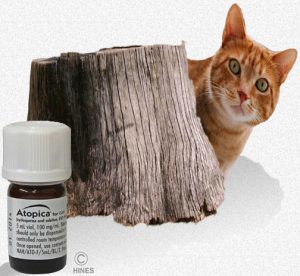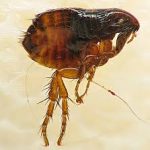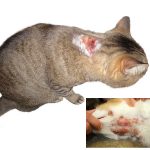Atopica® Cyclosporin For My Itchy Cat?
Ron Hines DVM PhD
I discourage giving oral forms of cyclosporin to your cat if a single flea or flea dirt was found on your cat or any pet or human family member in the past year. Cats that are allowed to venture out-of-doors can be assumed to have flea exposures now and then. Cats commonly develop skin allergies to flea saliva. Using powerful drugs like cyclosporin or corticosteroids to suppress the itching, skin damage and eosinophilic ulcers that fleas sometimes causes is unwise; much like shooting flies with a howitzer. There are safer treatment options for your cat.
For reasons unknown, Cyclosporin is can be spelled cyclosporine, ciclosporin, cyclosporin A or CsA. It is a protein peptide that is naturally found in several soil fungi. Some refer to the drug as an “immunomodulator”. That is because of the negative connotations when called what it actually is, an immunosuppressant . Over the years the oral form of cyclosporin has been sold as Neoral®, Sandimmune® and Atopica®. When cyclosporin is given topically as a 1% solution or 0.2% ointment for for “dry eye“, it is often effective in increasing your pet’s tear production and solving a dry, inflamed cornea problems. For that appears to be a safe use. (read here)
Oral cyclosporin products such as Atopica® are very effective in preventing or reducing all forms of non-infectious itching and scratching in cats no matter what the underlying cause might be. They do so by lowering the activity of an immune messenger chemical called IL-2 . IL-2 is produced by one of your cat’s many immune system cells, the T-cells. That in turn reduces the amount of several inflammatory cytokines in your cat’s skin produce itching. Those messenger chemicals (signaling molecules) are present in large amounts that they should be because of your cat’s allergies to flea saliva or other irritants. In rare cases, the itching occurs because of immune system mistakes.
Your cat should improve when given cyclosporin. Most cats do. However the drug is non-selective. It lowers the effectiveness of your cat’s entire immune system. Pharmaceutical companies more diplomatically call that “tuning down the volume” of your cat’s immune system. So many of the important safety mechanisms that your cat’s immune system must perform for good health will be “tuned down” as well. That includes the effectiveness of your cat’s immune system in preventing various cancers or holding cancerous cell numbers in check when some are already present. (read here) Cyclosporin also reduces your cat’ ability to fight bacterial infections. (read here) Infections caused by protozoa and fungi become harder to fight off as well. (read here) Cyclosporin has the potential for a variety of other serious side effects. (read here) It is not a kidney-friendly drug either. (read here)
If My Cat Takes Oral Cyclosporin Are There Things I Should Request?
Yes
If your decide that you cat needs to take cyclosporin, consider having its cyclosporin trough levels periodically determined. Perhaps your cat’s drug dose can be lowered and still be effective. The amount of cyclosporin that remains in circulation in a cat’s body after it consumes it varies greatly between pets. If cyclosporin is ineffective or only partially effective, your cat’s trough blood levels might be too low. In the one study I know of in people, combining cyclosporin with prednisone was not able to lower the dose of cyclosporin required. (read here)
A complete blood chemistry and white blood cell differential count prior to beginning cyclosporin would be wise. It can then be compared to one performed on your cat’s blood sample after has taken the medication for a while.
Posterior body and tail hair loss and skin lesions are cause by your cat licking and over grooming those areas. But head and neck lesions are due to your cat frantically scratching with its rear claws. Keep those claws trimmed short and filed smooth or purchase cat toenail guards. Hopefully, that will help. As politically incorrect as it is today, some of these cats would lead happier lives without their rear claws. It is always safer to have an experienced groomer or veterinary nurse clip your cat’s toenails than to attempt to do that yourself. Claw scratches on people can be an infection issue. (read here)
Are There Cyclosporin Alternatives?
Yes
Prednisolone And Prednisone
Prednisone and cyclosporin are equally effective in their ability to reduce itching in dogs. They are probably equally effective in cats as well. (read here) Many veterinarians prefer prednisolone over prednisone when medicating cats. However it has never been fully verified that one is more effective than the other.
The immune system malfunctions that lead to itchy cats are highly complex, unpredictable and not fully understood. So there might be cats for which Atopica®/cyclosporine is your best choice. But it would not be my first choice. My first choice would be the judicious, intermittent use of a relatively low dose of oral prednisolone combined with life style changes designed to minimize the problem: One of the newer oral or topical monthly flea control medications would be a must. Confining your cat to indoor living would be another. Frequent nail trimming, time-occupying activities such as puzzle feeders and itch-relieving soothing shampoos are all beneficial. You can only determine what works best for your cat through trial and error. Physicians have found that skip-day, skip days, treatment significantly lower the incidence of side effects. (read here)
I begin by giving a substantial daily dose of oral prednisolone for the first week. Then I gradually attempt to lower the dose with my goal being to finding the smallest amount of prednisolone that keeps the cat’s skin issues under control, when given the least frequently during the week or perhaps just during flare ups. If taste is an issue, various veterinary compounding pharmacies will supply the drug in liquid form and in various flavors perhaps more acceptable to your cat.
One potential side effect of prednisone/prednisolone (and all corticosteroids) is elevating your cat’s blood glucose level. (read here) Cyclosporin is not free from that potential either. (read here) However cats often have anxiety-related, moderately-elevated, but irrelevant blood sugar reading and elevated blood pressure when they visit animal hospitals. Both go back down when you return home. A better monitor of your cats long-term blood sugar level is the glycosylated hemoglobin/fructosamine test. That test is similar to the A1c test which measures sugar level over longer periods of time in humans. As in humans, persistently high blood sugar readings in cats can be a prelude to diabetes. (read here) Keeping your cat a healthy weight is also quite important. All corticosteroids increase appetite.
Another possible side effect of corticosteroid therapy is a moderate increase in your cat’s white blood cell count (numbers). Should that occur, neutrophil numbers generally go up and lymphocyte numbers usually go down. That can be a temporary event or continue throughout treatment. If it occurs, changing your cat’s dose and frequency often minimizes those changes. Cyclosporin is not free from similar effects. (read here)
If your cat’s baseline eosinophil numbers were above normal due to its skin allergies, a return to normal eosinophil numbers during treatment is a very good sign. High blood eosinophil counts can also be associate with parasite issues.
Excess corticosteroid in your cat’s body – either produced internally by your pets adrenal glands (=Cushing’s Disease) or given as a medication – amplifies your pet’s appetite, increases its body fat storage and promotes fluid retention. That can be minimized or eliminated through dose adjustment, exercise and diet. It is quite important that you not allow a cat receiving prednisolone/prednisone to gain excessive weight. That might mean purchasing an accurate scale and keeping a diary. It also might mean purchasing a lower-caloric cat food, preparing a low-cal cat diet at home or lowering the amount of food you offer. I prefer a home-prepared nutritionally-correct, lower calorie diet for cats in situations where they are gaining excessive weight or need to loose weight. (read here)
On either cyclosporin or prednisolone, obtaining blood panels three times a year is advisable when your cat appears to you to be stable. But unintended weight gain or loss, decreased activity level, changes in attitude, appetite or urinary or defecation habits are all things that warrant a conversation with your veterinarian.
With either drug, I like to give as long a medication-free rest period every few months as your cat can tolerate. Not all cats can have medication holidays but some can – particularly when their problems are seasonal. If the medication you are giving is a corticosteroid, never stop giving it abruptly. Instead, slowly reduce the dose until none is given. I have always felt that it was safer to give a bit larger dose of prednisolone every few days than a somewhat smaller dose every day. Traditionally, many veterinarians have felt that the drug-free days allow your cat’ adrenal glands to remain healthier. (read here)
You are on the Vetspace animal health website
Visiting the products that you see displayed on this website help pay the cost of keeping these articles on the Internet.



